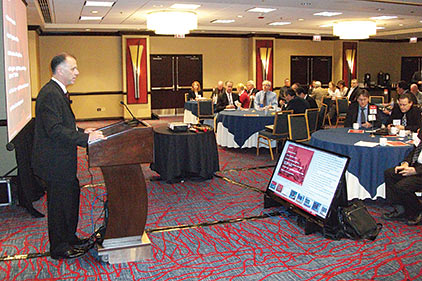
|
| John Galyen, president of Danfoss, North America, greets attendees at the company’s 20th annual press conference at the 2015 AHR Expo. |
Danfoss used its 20th annual press conference at the AHR Expo to launch ‘Engineering Tomorrow,’ which it said was “a new global brand profile.”
“Engineering Tomorrow links our foundation of innovation, quality products, and reliability to the future market needs of our customers and societies around the world,” said John Galyen, president of Danfoss, North America.
In a statement provided in press materials, Niels B. Christiansen, CEO, Danfoss, said: “Engineering is at the very heart of Danfoss. Building on this, we are ready to shape the future through innovative solutions. The world presents significant growth opportunities and Danfoss is ready to seize them. We have achieved good results and have strong and positive stories to tell. Now, we invest in getting this message out.”
Through Engineering Tomorrow, Danfoss said it will focus on innovative solutions involving:
• Infrastructure — “Including HVACR systems in commercial and residential buildings, water and wastewater, smart cities and smart grids;”
• Food — “To ensure the safe, energy-efficient, and environmentally friendly movement of food through every aspect of the chain, including agricultural equipment, food and beverage manufacturing, cold storage, shipping and transportation, and supermarket and other retail locations;”
• Energy — “To reduce consumption in buildings, motors, data centers, and other energy-intense applications;” and
• Climate — “With solutions to help achieve emissions reductions through lower energy use and more environmentally friendly substances including low-GWP (global warming potential) and natural refrigerants.”
The hour-long event focused on a range of topics, from regulatory issues to next-generation building efficiencies related to intelligent equipment to high-efficiency retrofits.
Regulatory Affairs
Mark Menzer, director of public affairs for Danfoss, reviewed ongoing public-policy discussions, from a global perspective on a phasedown in use of hydrofluorocarbons (HFCs) and attention turning to such refrigerants as hydrofluoroolefins (HFOs), CO?, hydrocarbons (HCs), and R-32. Because of the mild flammability issue of some of those refrigerants, Menzer said efforts continue to get direction through ASHRAE’s Standard 15. “This is a top priority,” he said.
Meanwhile, he said, attention should also be paid to the U.S. Department of Energy (DOE), which is currently dealing with a range of issues related to energy efficiencies. “There is a need for transparency in the process,” he said.
Next-generation Building Efficiency
Jeff Staub, application engineering manager for Danfoss, discussed the importance of considering the whole building as a system, emphasizing the importance of understanding an entire building envelope and the need for integration.
He stressed the importance of what he called “stakeholder collaborations” involving component manufacturers, system manufacturers, building engineers, owners, contractors, and utilities.
Intelligent Equipment
Mike Schwartz, CEO, Daikin Applied, talked about intelligent control for building efficiency. He noted the significant progress that has been made in improving the energy efficiency of buildings and HVAC equipment citing a 50 percent improvement since 1989.
“But, now, we are getting to the point of diminished return,” he said. “Where do we get the next level of efficiency gains?”
The answer, he said, comes with better controls and ways of managing the building itself through the use of inverter compressors, dynamic magnetic bearing chillers, and R-32 instead of R-410A.
High-efficiency Retrofits
Gene Ameduri, president and cofounder of Enerlogics Networks Inc., referenced the company’s participation in a retrofit project at the U.S. Steel Tower, a 64-story building that was built in 1971
in Pittsburgh.
Ameduri discussed the many technologies — two 3,500-ton chillers, one 1,500-ton chiller, two 1,600 boiler horsepower (bhp) boilers, 12 200-hp variable frequency drives (VFDs), and more — used to make the facility more efficient and desirable to tenants.
Publication date: 2/23/2015
Want more HVAC industry news and information? Join The NEWS on Facebook, Twitter, and LinkedIn today!


Report Abusive Comment